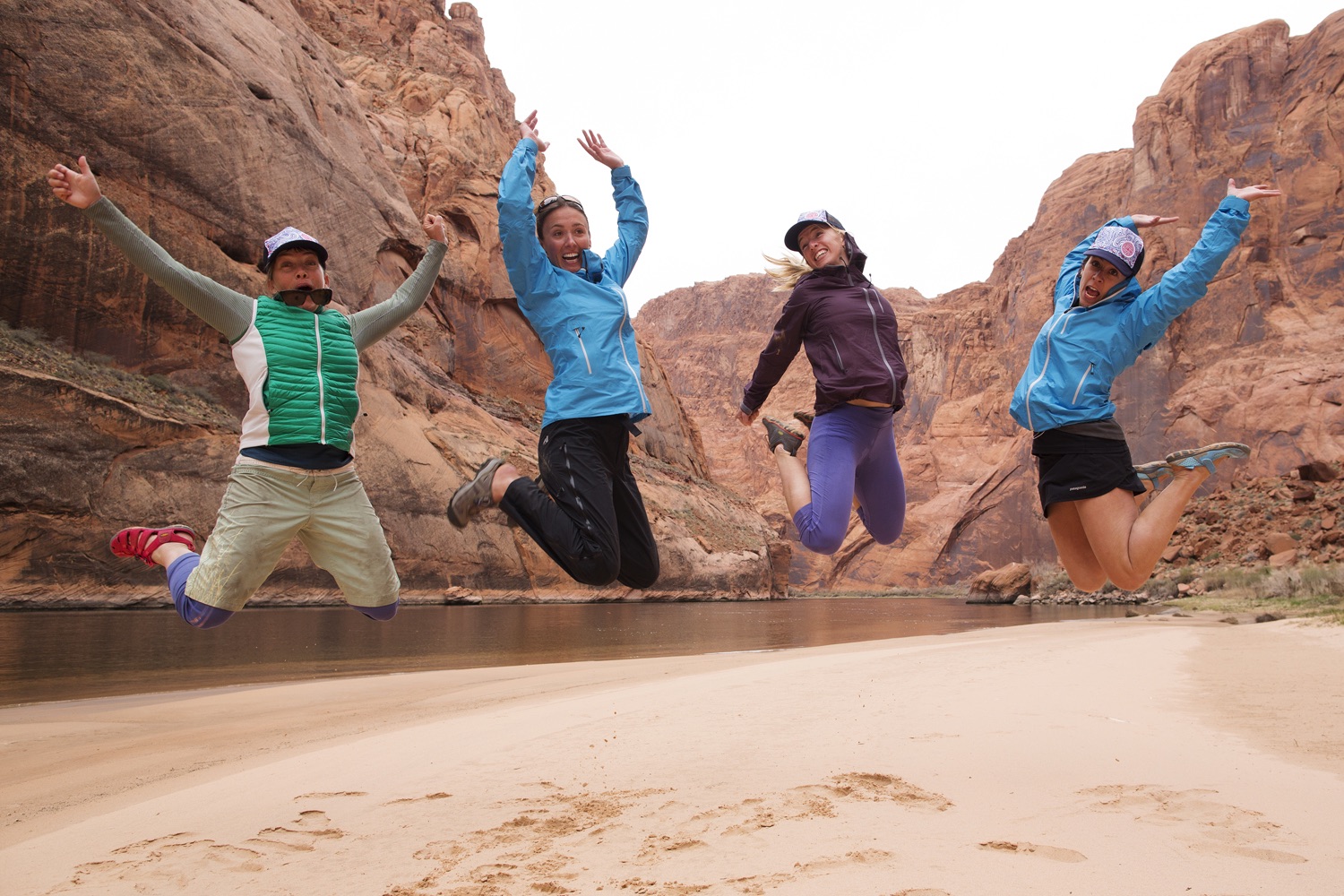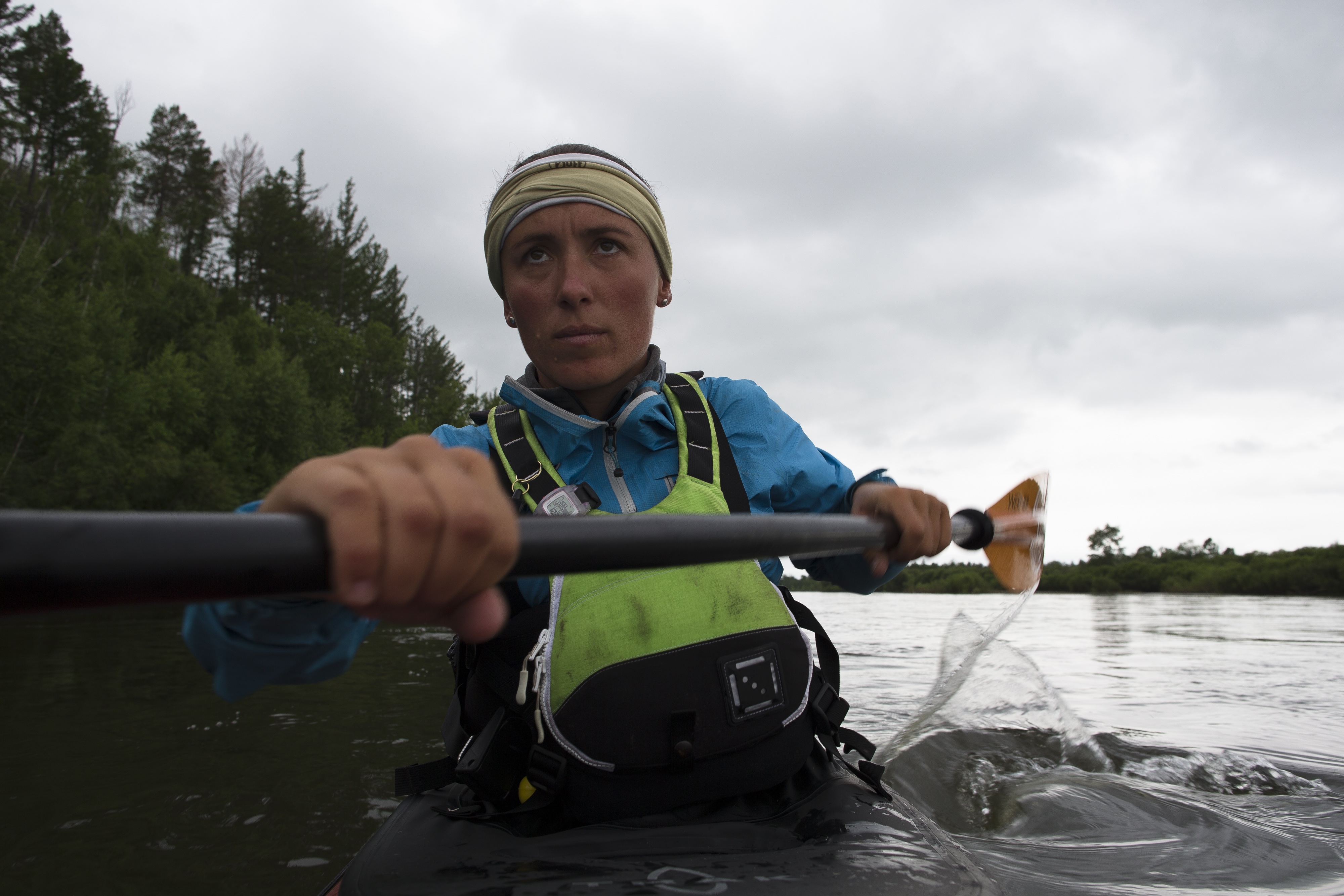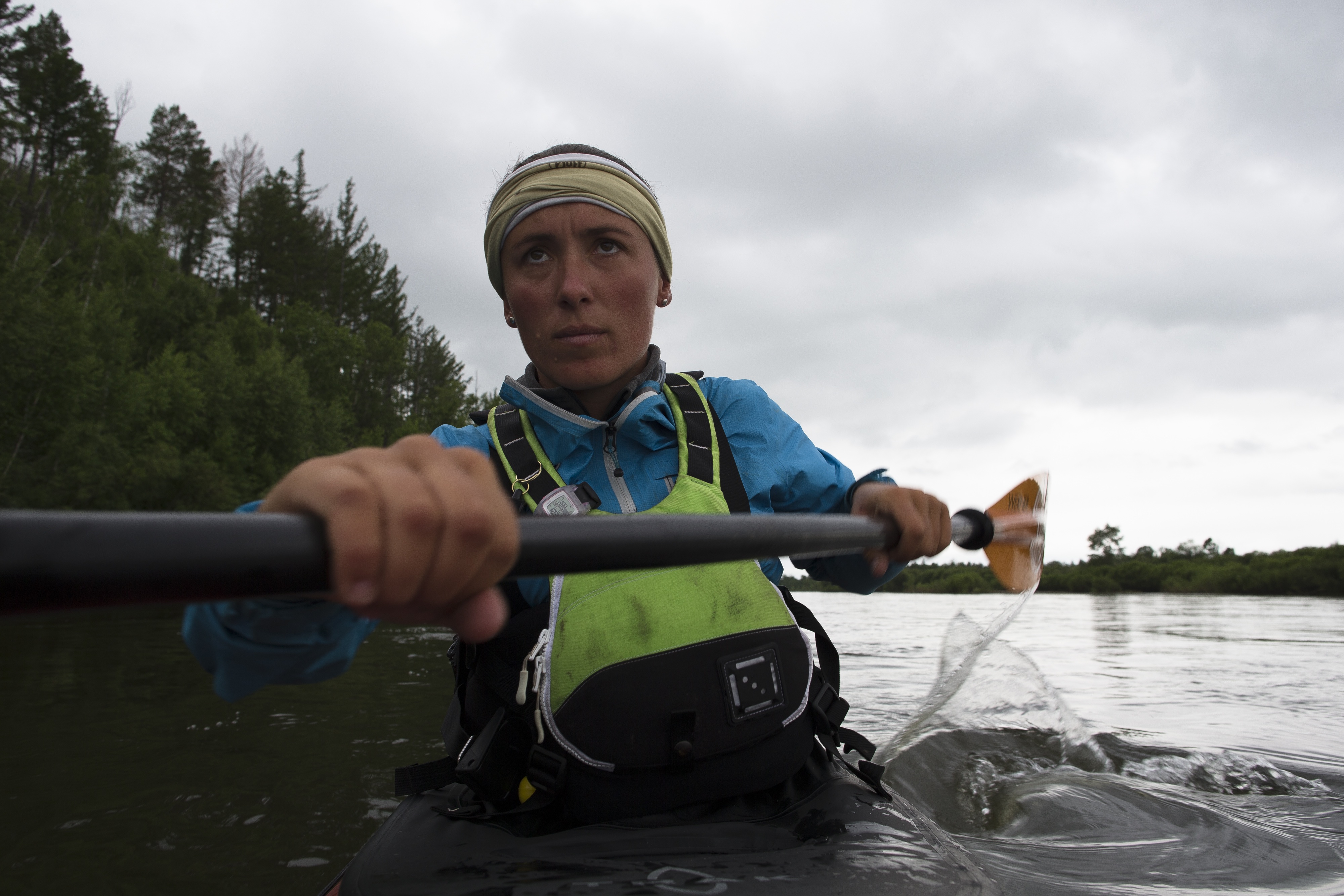‘Adventure never goes to plan’ with Krystle Wright
Krystle Wright is fearless. She has gone free diving to capture striking sunlight filtering down from above to outline a snorkeler for a beautiful photograph. She’s hung off the sides of cliffs to capture climbers making ascents and even lives out of her vehicle, roaming Australia in between bouts in foreign lands where she takes incredible photographs and videos of other amazing adventurers. Sounds like a pretty sweet life, yeah?
In the summer of 2013, Krystle mounted a half-wild horse and made her way to the Onan River headwaters in Mongolia. At her side were wilderness physician’s assistant Amber Valenti, Grand Canyon river guide Becca Dennis and river ecologist Sabra Purdy. The three knew about as much Mongolian as Krystle: none. Their native guides leading the trio from the road to the river lacked navigational technology and knowledge of English, but followed “Hobal,” or Mongolian intuition, and offered kindness and care as they led the four women, kayaks and plenty of gear to the sacred beginning of the river on horseback.
The plan? Traverse the third longest free-flowing river in the world while documenting their journey. The result? One terabyte of film, 23,000 photographs and one beautiful video, “Nobody’s River.” The stunning documentary won the 2014 Spirit of Adventure Award at the 5 Point Film Festival.
Krystle is only 28 and an acclaimed adventure photographer and videographer. Her incredible works have been noticed by the likes of National Geographic Adventure, Canon and Keen. She heard of the Nobody’s River trip from a friend and immediately got in contact with Amber.
“I just knew it was a project I wanted to document and be a part of,” she wrote.
“I am attracted to places I’ve never been before and the further off grid I am, the happier I am,” Krystle said.
Even though she had only minimal recreational kayak experience and had never met Amber, Becca or Sabra, Krystle was psyched that the river trip encapsulated much of what drives her: adventure and far-away places.
The Onan river, where the trip physically began, starts out in Mongolia and turns into the Amur River Delta in Russia. Crossing these parts of Siberia often requires serious bribe money, detrimental connections and even involves potential danger in getting lost in marshy, difficult-to-navigate areas.

The four ladies made their way through more than 5,000 km in the Amur Basin, spending most of their time in kayaks, with some train, van and ferry rides in between. Their trip could have never happened if it weren’t for grants and creative fundraising including an Indiegogo campaign that raised a total of $32,295 in just 17 days.
The women also had sponsors, including NRS, Trak Kayaks, Keen, Eddie Bauer and Big Agnes. They received grants from Polartec and National Geographic. Krystle wasn’t around for much of this process as she wasn’t brought on to the trip until a lot of the finances were already in place. Amber and Becca were the major champions when it came to this aspect of the journey, Krystle said.
But back to the horses and the Onan headwaters. Did we mention it was storming and lightning like mad in the distant mountains as the women got their start? After their horseback trek, the group finally said goodbye to their cheerful, intuitive Mongolian guides and started assembling their folded kayaks at the riverside.
They used Trak T1600 models, which can handle the Amur River Basin watershed and also pack down to the size of a golf bag. Inside the kayaks went your typical gear: sleeping bags, a stove, performance clothing and a plethora of camera equipment. Sabra also took along some scientific gear to track the ecosystems they passed through. With everything loaded and paddles in hand, the ladies set out.
In total, the four spent two months on this incredible journey. They slept on the sides of the river when they felt like calling it quits for the day.
There are no special allotted campsites or fights for the best views like so many campers experience in U.S. National Parks. Due to the very real possibility of bears, wolves and other furry carnivores, the women opted to eat vegetarian fare throughout the adventure. Krystle said Amber follows the diet in her home life, so she was one of the main cooks.
Carrying two months worth of food at once is both heavy and unrealistic, so the group sourced bread, pasta, rice and canned tuna at their few stops along the way. They did pack some items, like dried veggies, fruit and powdered coconut milk, which Krystle says was “worth more than gold.” She also admits to bringing along her two must-haves: music and chocolate. She’s a major hot chocolate fan that claims to have had at least 85 of the warm drinks during their time on the water.
The “Nobody’s River” film starts out with a quote from Amber:
“We couldn’t have known it at the time, but we were about to go on a very different journey than we had planned.”
Krystle agreed. Not only were the river and the cultures they traveled through full of surprises, but the team received some bad news before the trip began. Becca’s long time partner and fellow outdoor sports enthusiast Zach Orman had died in a freak paragliding accident just weeks after the team first met up in Arizona for some pre-trip planning. Becca wondered whether she should go on the journey at all. A friend told her to “just get to the river” and she decided to follow through.
She paddled with the women until the Mongolian Onan turned into the Russian Amur, at which point she felt it necessary to return home. One of the most poignant parts of the film occurs right after her early morning departure, as Amber speaks from her heart directly to the camera. You’ll have to watch the film to understand the beauty and strength that Becca and all the women showed throughout the journey.
Krystle told us it’s very difficult to encapsulate all the emotions they felt in words.
The landscape alone inspired so much awe, it had to be quite the experience to go through joy, pain, fear and mourning all in the middle of nowhere such a short time after the death of a loved one.
The trip was also full of happy moments, ones where the women donned crazy patterned outfits and danced about their campsites. Or even the night they watched (and then got involved in) traditional Mongolian wrestling. It included a lot of thigh slapping and referees who got up close and personal with the competitors. (We recommend watching “Nobody’s River” to see what we’re talking about.)
At one point along the journey, the ladies were camped on the Mongolian Steppe. They set their Big Agnes Copper Spur tent next to gers (yurts), where they spent the evening eating with a native family. Their driver, a welcoming fellow, passed around teacups of homebrewed vodka made from fermented milk. All but Krystle enjoyed several cups of the drink (Amber claims to have had a total of 7) before retiring.
When she woke up early the next day, Krystle exited the tent, leaving the other three trying to sleep off their late evening indulgences. After wandering the land, camera in hand, the photographer returned to the tent, only to find a herd of baby goats had taken an interest in the temporary structure and were trying to climb it. The photo was featured in Outside Magazine in February, 2014, and is just a glimpse into Krystle’s favorite memory from the trip.
Not every moment of the Nobody’s River journey was a dance party (although many were had with the group’s portable speaker). At one point, the Mongolian military thought the group were spies and took them off the river for 6-7 hours of interrogation.
Krystle didn’t know what would happen if they were caught by Russian authorities.
The women may have been forced to pay a large bribe or even ended up in jail. Thankfully this didn’t happen as the group took to the waters cautiously, often during off hours when the industrial areas were quiet and no one could be seen.

On the Onan, the sides of the river were green and grassy, with hills and mountains surrounding the paddlers as they made their way east. The women sanitized their water with a Sawyer 4 liter filtration system, which removes even viruses that cause common sicknesses. Once on the Russian side of the Amur, however, the watershed became incredibly polluted.
“The Amur had so many diseases, viruses and pollution running through it that it just wasn’t worth the risk…” Krystle said about drinking from the river. The four learned some basic Russian in order to ask local villagers they paddled past if they could fill up bottles from their taps. Even then, they ran the water through their filtration system to ensure they did not become ill from trying to stay hydrated. Getting sick in such rural areas was not an option, although they carried an extensive first aid kit and had Valenti’s wilderness medicine training on their side.
Another difficulty of their journey? The mosquitoes and gnats were relentless.
As Krystle put it, “From dusk till dawn it was the mosquitos that would rage, and from dawn until dusk the gnats would take over.”
In the film there is a shot of just mosquitos and gray sky as the bugs hungrily swarm, filling the air with an overwhelming, buzzing resonance. Krystle is convinced that Siberian mosquitoes are a breed of their own. The relentless creatures were abundant throughout the 5,000+ kilometer trip and continually tested the patience of the women as they flew into their food, water and tent.
The ladies made it to the end of the rivers where they meet the Sea of Okhotsk and the Pacific Ocean, but they did not paddle the entire way. Once the women reached Russia, they became concerned about the possibility of getting lost in the immense Amur basin among the many oxbows (lakes that are built into the river bends). The water was high and finding dry land to camp on was sometimes a several-hour ordeal. Sabra developed tendinitis in her wrist, and terrible bugs plus questionable weather only added to their fears.
Nine days into the Amur portion of their journey, the trio opted to get off the water and find another way to the sea. Abandoning their goal of using only man(woman)power to get from the start of the Onan to the end of the Amur was an unbelievably difficult decision. Krystle had a really hard time settling on this idea but Valenti had a very bad feeling about continuing on their current pathway and she couldn’t shake her intuition. Sabra came around to her idea of finding another route besides the water and eventually so did Krystle. The women knew they would very likely never return to this region, so opting to change from their original plan was a huge decision to come to.
Krystle is very thankful Valenti spoke up when she did and that they left the ancient waterway. Shortly after the Nobody’s River journey ended, record floods hit the Amur River Delta, causing the water to rise several meters, drastically changing the landscape and the lives of those who call the river’s edge their home. Had the women stayed on the water they may not have been able to navigate and could have even lost their lives.
Once the decision was reached, the ladies pulled off the river and boarded a 10-hour ferry from Komsomolsk to Nikolaevsk Na Amure, where the residents supposedly hadn’t seen “tourists” in at least two decades. From there it was just 35 kilometers to the ocean. They hitched a ride with all their gear and were dropped off in a nearly-abandoned fishing village at the coast. Their adventure was finally coming to an end.
It was nothing like the lush, natural areas of the Onan headwaters in Mongolia. Instead, the three were surrounded by rusting industrial remnants and missing a beloved team member. Wright got out her camera and started taking photographs, trying to capture the incredible, momentous occasion. There was clapping, dancing and even crying as they thought of Becca and her lost partner and all that they had been through during the 56-day trip and several years of planning. What started out as a few friends and a near stranger headed on the trip of a lifetime had reached and surpassed all their expectations in more ways than you can count.
“An expedition will challenge you,” Krystle said,” and I appreciate the ups and downs as it’s a way to help grow and evolve.”
The ladies, who deemed themselves a tribe, still talk occasionally. Krystle even thinks their relationships are stronger now that the Siberian trip is over. She doesn’t define friendship as the time you spend with someone, but instead as the connection you have with one another and the ability to pick up a conversation as if no time has passed.
When asked if she has any advice to offer fellow lady adventurers, Krystle shared, “It doesn’t matter how big or small your adventure is, you just have to get out and do it.”
“It’s really amazing what you can do when you don’t let the judgment of others and even yourself hold you back,” She added. “Life’s too short to worry about what others think.”
What happened when the Nobody’s River ladies left Russia? The women headed to their respective homes and continued on their own adventures. Most recently, Krystle is off on a journey to photograph Sarah Marquis as she walks across the rugged back country of Australia’s Kimberley region for National Geographic.
Follow Krystle on her adventures:
Instagram: @krystlejwright
The Web: www.wrightfoto.com.au

